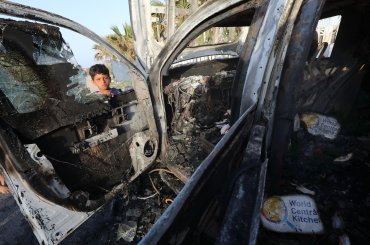The explosive news from Israel/Palestine gave Thomas Friedman, the New York Times foreign affairs columnist who portrays himself as a Middle East expert, a chance to start explaining why Palestinian resistance and Israeli repression have reached the highest level in years. In his column yesterday, he failed.
He nowhere wrote the words “Israel apartheid,” or mentioned the landmark Human Rights Watch report that appeared on April 27 and that provides the best framework for understanding not only the Palestinian resistance to ethnic cleansing in Jerusalem, but also to the uprisings among Palestinian citizens of pre-1967 Israel. Instead, he flails about, making several silly, sometimes offensive points that explain little.
First, the silliness. He repeatedly cites the TikTok video app, implying that “young Palestinians” have been getting “inspiration” from watching an “Orthodox Jew” being attacked. His assertion distorts and trivializes; Palestinians have been resisting the theft of their land and their second-class citizenship for decades before the internet was invented.
He also attacks Hamas, which he says “has failed to produce either significant economic growth in the Gaza Strip that it rules or political progress with Israel.” Can Friedman really be this ignorant? You can dislike Hamas without blaming it for economic stagnation in a territory that Israel blockades and has turned into an open-air prison.
Friedman also makes a more substantive point, but hides his own responsibility. He says
[A] dangerously naive consensus has emerged in Israel in recent years suggesting that Israel basically has the Palestinian conflict suppressed and those Palestinians living in the West Bank and East Jerusalem are basically resigned to living under permanent Israeli control.
Friedman is right, but where was he as this “dangerously naive consensus” was congealing? He was busy gushing over Israel’s normalization of relations with the United Arab Emirates and other conservative Arab states: “A Geopolitical Earthquake Just Hit the Mideast.” Friedman occupies some of the most valuable journalistic real estate in the world, and he could have been issuing warnings.
Next, he waits until paragraph 18, but he finally does say that beleaguered Prime Minister Benjamin Netanyahu could benefit politically from the unrest “by inflaming the situation so much that his right-wing rivals have to abandon trying to topple him and declare instead that this is no time for a change in leadership.” Surely this is a more important point than Palestinian youths watching Tik-Tok videos, and he should have put it right at the beginning of his article.
Netanyahu’s maneuvering is definitely worth analyzing, and skilled Israeli journalists have been doing just that. The Israeli prime minister would have gained by provoking the U.S. into attacking Iran, but embroiling Israel in another conflict in Gaza is another matter, which could damage him at home, especially if Hamas can prolong the armed resistance. He is probably genuinely conflicted.
Friedman has a top job because he is supposed to have special insights. He surely has seen Netanyahu up close for years, and he should have analyzed the Israeli leader further — and he should also have risked putting forward his own opinion on what Netanyahu will do.
But Friedman’s larger failing is that he nowhere cites the Human Rights Watch report on Israel’s apartheid. (His whitewash is right in step with his Times colleagues; after one original article, the paper has not mentioned the 213-page report a single time.) Friedman doesn’t even have to accept all the Human Rights Watch findings, but he should acknowledge that it frames the current events there better than Tik-Tok:
* The Palestinian uprising in Jerusalem’s Sheikh Jarrah neighborhood is not “a real estate dispute,” as the Israeli government contends, but the latest resistance to a many decades-long pattern of Israeli ethnic cleansing in occupied Palestine.
* The sudden resistance among Palestinian citizens of pre-1967 Israel is not a complete surprise, but the consequence of being treated as second-class by an Israel that proudly proclaims itself “a Jewish state.”
Let’s turn to Haaretz, the Israeli daily, to see a vital angle that Thomas Friedman might have written about. In an editorial yesterday headlined “Israelis don’t need more lethal muscle-flexing,” the paper said that the recent flare-ups are largely the fault of Israel’s government, abetted by far-right groups, who carried out “provocations planned in advance to demonstrate mastery and control. They have carefully marked a path that has led to violence and could drag Israel into a war.”
You won’t see anything like this in Thomas Friedman’s column.



Well said! Excellent piece.
Every time he opens his mouth something soft and brown falls out. I’d love to see him dropped into Gaza. With or without parachute…
I could use help here from someone more familiar with Yiddish than I am. Does Thomas Friedman qualify as a schlemiel or a putz, or both, or is there another, much better Yiddish term to describe this a**hole?
The American Press is a wasteland when it comes to fair coverage of Gaza, Israel and Iran. Friedman has been worthless for years. His one useful act was to call the standing ovations Netanyahu received from Congress as “bought and paid for by AIPAC.”
So called “progressive” Rachel Maddow hasn’t mentioned Gaza this week. How many dead children in Gaza will she need to break her silence?
https://www.wednesdayswars.com
Memo to Thomas Friedman, gutless Zionist lackey:
End Brutal Repression of Palestinians Protesting Forced Displacement in Occupied East Jerusalem – Amnesty International USA (amnestyusa.org)
Amnesty International, May 11/21
“END BRUTAL REPRESSION OF PALESTINIANS PROTESTING FORCED DISPLACEMENT IN OCCUPIED EAST JERUSALEM”EXCERPT:
“’Evidence gathered by Amnesty International reveals a chilling pattern of Israeli forces using abusive and wanton force against largely peaceful Palestinian protesters in recent days. Some of those injured in the violence in East Jerusalem include bystanders or worshippers making Ramadan prayers,” said Saleh Higazi, Deputy Director for the Middle East and North Africa at Amnesty International.
“’The latest violence brings into sharp focus Israel’s sustained campaign to expand illegal Israeli settlements and step up forced evictions of Palestinian residents- such as those in Sheikh Jarrah – to make way for Israeli settlers. These forced evictions are part of a continuing pattern in Sheikh Jarrah, they flagrantly violate international law and would amount to war crimes.”
“‘Eyewitness testimonies – as well as videos and photographs taken by Amnesty International’s researchers on the ground in East Jerusalem –show how Israeli forces have repeatedly deployed disproportionate and unlawful force to disperse protesters during violent raids on al-Aqsa mosque and carried out unprovoked attacks on peaceful demonstrators in Sheikh Jarrah.
“‘Since the beginning of Ramadan on April 13, tensions have been steadily rising as Palestinians protested against Israeli restrictions limiting their access to Damascus Gate, a main entrance to the Old City of Jerusalem. On April 26, Israeli authorities removed the restrictions in response to the continuous demonstrations. Anger has also been rising over the imminent plans to forcibly evict four Palestinian families from Sheikh Jarrah to make way for Israeli settlers.'”